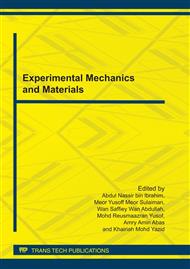p.1
p.7
p.13
p.19
p.22
p.28
p.35
p.41
A Parametric Analysis of the Strength-Porosity Relationship of Green Compacts Formed through Powder Compaction Route
Abstract:
The strength of a green compacts formed through warm powder compaction route is strongly dependent on the forming load and temperature. As the forming load increases, the powder particles move from its initial position by sliding among them and die wall. This movement results in new arrangement and packing order of the particles. However, due to this movement, pores among the particles are generated that affects the mechanical properties of the green compacts. Having pores in green compacts lead to strain intensification at ligaments between pores during sintering at later stage, hence serve as areas for crack initiation. Therefore, as the powder forming relates directly to the load and temperature, strength to porosity relationship has to be analyzed based on those parameters. This paper presents the effect of porosity to the strength of green compacts formed at different load and temperature (70 kN to 130 kN; 30°C to 200°C). The bending strengths of green compacts are measured while Scanning Electron Microscopy is used for porosity evaluation. It has been found from the results that porosity and strength are related to each other at all forming parameters. In addition, high forming load and temperature give better strength due to porosity reduction.
Info:
Periodical:
Pages:
1-6
Citation:
Online since:
July 2011
Authors:
Keywords:
Price:
Сopyright:
© 2011 Trans Tech Publications Ltd. All Rights Reserved
Share:
Citation:


